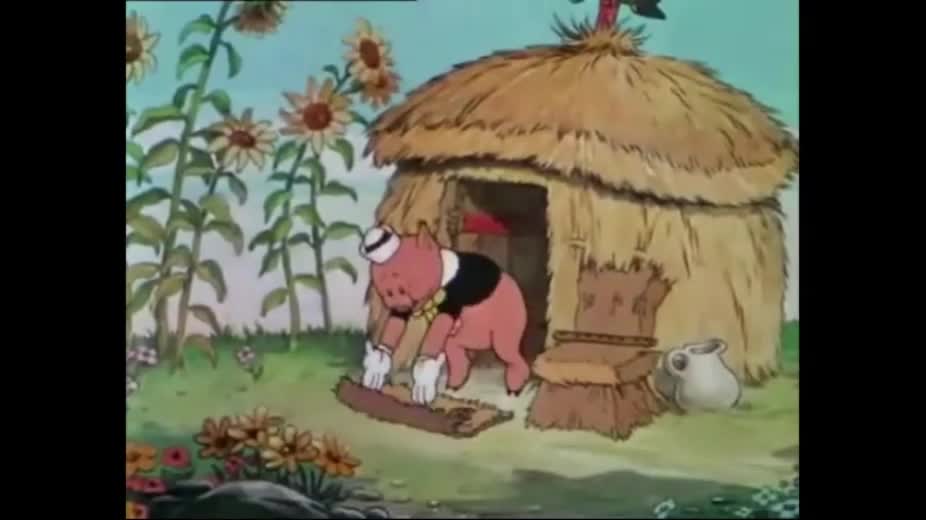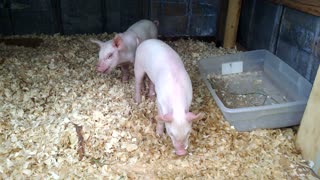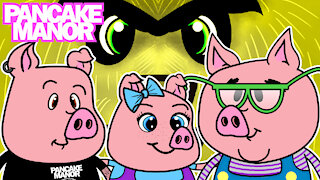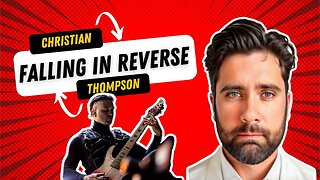Premium Only Content

Three Little Pigs c.1933 : Character body language is key
There’s a moment, about three and a half minutes into the Silly Symphony short Three Little Pigs, when the Big Bad Wolf is about to blow down one of the pigs’ houses. He gets himself in the headspace to get a-blowin’ and then prepares physically by breathing in more and more air, his chest heaving and expanding with each gasp. Finally, when his chest is about to burst, he lets out a gust of wind powerful enough to knock down the poor piggy’s home. As drawn by Norm Ferguson, perhaps best known as the creator of Mickey’s dog Pluto, the Big Bad Wolf was a benchmark in terms of character animation. Chuck Jones commented that the film made him realize “something was happening there that hadn’t happened before.” Jones said that it showcased a major principle in character animation, that “it wasn’t how a character looked but how he moved that determined his personality.” He even argued that character animation truly began with the film.
Disney himself agreed. Notorious for finding fault in just about anything he produced, upon finishing the short, Disney exclaimed, “At last we have achieved true personality in a whole picture!” And as a result, Three Little Pigs was hugely influential both inside and outside the studio.
Internally, the short featured an original song by Frank Churchill, Ted Sears, and Pinto Colvig, and the use of original music would become a convention of many Disney shorts that followed. Also, thanks largely to the work done by Freddie Moore, a hugely talented and influential artist at the studio, the storytelling and animation style at Disney began to shift. The “rubber hose” style of animation was out; the more naturalistic and complicated “squash and stretch” style was here to stay. It was a huge success for the studio, too, winning an Academy Award and making a truly unbelievable amount of money; the following year, the studio’s net profit was estimated at more than $600,000 and led to Disney’s expansion. One theater played the short for so long that it started adding whiskers to a poster for the short outside the auditorium; as the run went on, the whiskers would get longer and longer.
Most crucially, Three Little Pigs was one of the first of Disney’s films to feature a story department, which included Ferguson, Art Babbitt, and Dick Lundy. (It was also, not coincidentally, one of the first animated films to be fully storyboarded.) While Disney had established a story department before 1932, the success of Three Little Pigs, the creation of which Disney himself was heavily involved in, made him double down on his desire to create specialized roles for talented people that ran in direct opposition to the studio’s earlier, looser, everybody-chip-in ethos. And that story department would prove crucial in the years ahead as he marched toward a feature-length animated film.
Culturally, though, Three Little Pigs had an even larger impact. It proved that Walt’s work, far from being trifles for kiddies, could be considered high art, and the short, along with Disney himself, was fêted widely by the Hollywood elite and embraced by critics. As a metaphor for the Great Depression, then in its fourth year, it also spoke volumes, with the wolf representing the country’s economic hardship and the industrious, hardworking pig serving as a metaphor for Roosevelt’s New Deal. It became something of an anthem for a beleaguered country; its audio was played over the radio and its plot satirized in the newspaper. When fascism began bubbling up in Europe, the pigs with houses of straw and sticks were repurposed as a desperate warning call to Western nations not taking the Nazi threat seriously. (It should be noted that the original version of the short featured the Wolf dressing up as a “Jewish peddler,” a distressing moment that has been edited out of subsequent versions beginning in 1948; the choice didn’t help Disney’s case when he was accused of anti-Semitism.) And the song, “Who’s Afraid of the Big, Bad Wolf?,” was influential too, inspiring Edward Albee to title his hit play Who’s Afraid of Virginia Woolf?
https://www.vulture.com/article/most-influential-best-scenes-animation-history.html
-
 0:16
0:16
Mr2217
5 years ago $0.05 earned3 little pigs
2701 -
 0:25
0:25
Binny2020
4 years ago2 Little pigs
123 -
 7:13
7:13
Pancake Manor - Music for Kids
4 years ago $0.71 earnedTHREE LITTLE PIGS ♫| Nursery Rhymes for Kids | Pancake Manor
9811 -
 0:33
0:33
WFTX
4 years agoMicrosoft body language software
199 -
 1:47
1:47
Panho
5 years agoMy little pigs
79 -
 0:15
0:15
TheePro
5 years agoEverybody understands body language
94 -
 3:06
3:06
WFTX
5 years agoFood Truck Friday: Three Little Birds Breakfast Truck
61 -
 32:09
32:09
ThisIsDeLaCruz
1 day ago $6.52 earnedFalling In Reverse: Christian Thompson’s Stage Tech Revealed
45K8 -
 4:41:02
4:41:02
SynthTrax & DJ Cheezus Livestreams
1 day agoFriday Night Synthwave 80s 90s Electronica and more DJ MIX Livestream 80s Night / Late Night Nostalgia
52.4K7 -
 4:05:52
4:05:52
Nerdrotic
15 hours ago $27.41 earnedHollywood REGRET | Disney's Predator | The Feminist Avengers - Friday Night Tights 379
79.9K21